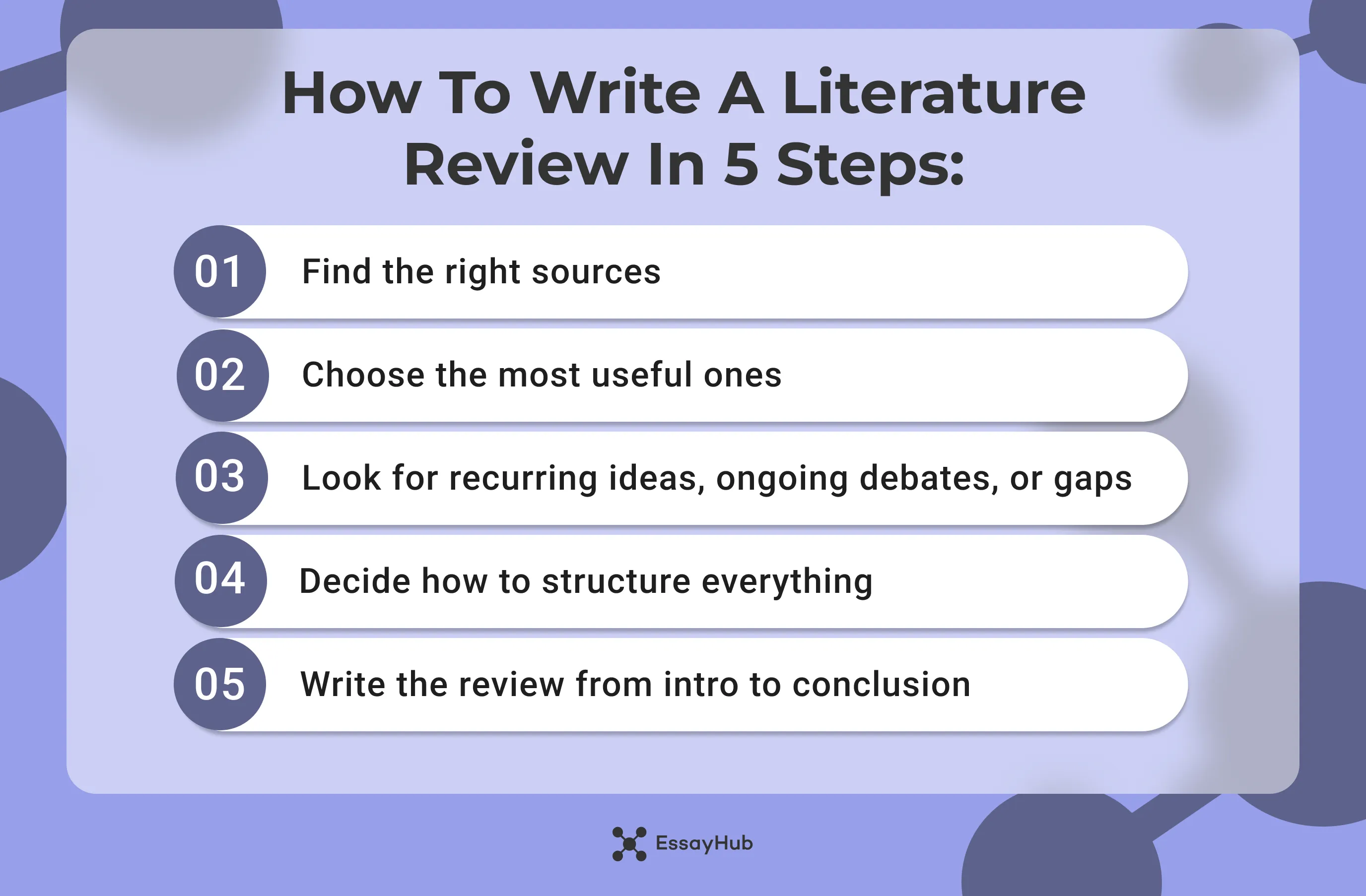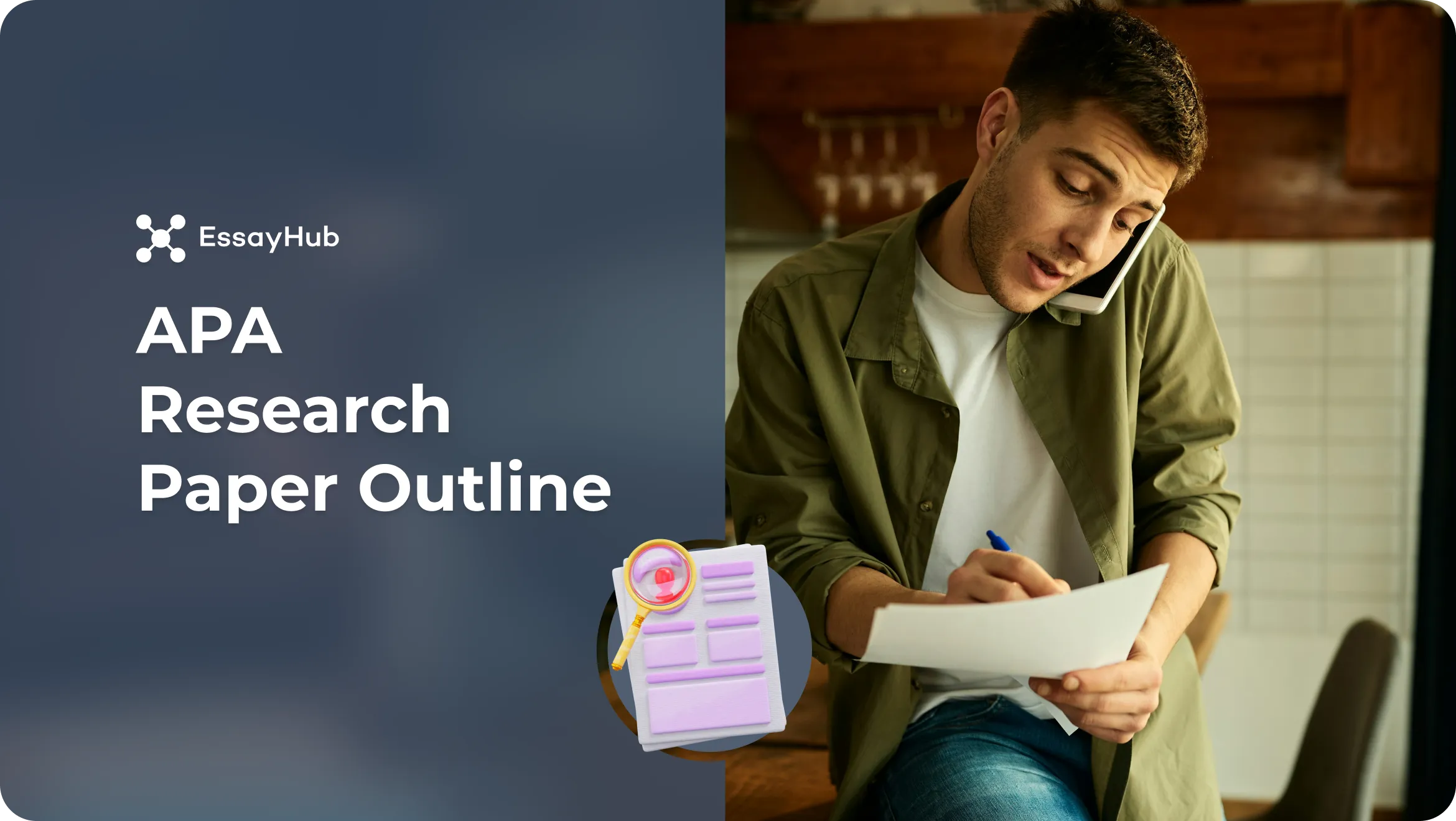A literature review is a summary of all existing research on a topic you’ll be researching. Here’s how writing one typically works, step by step:
- Defining your research question
- Researching relevant scholarly sources
- Reading and evaluating your sources
- Identifying patterns, gaps, and themes
- Writing your review
This guide will teach you the entire process of writing a literature review. Meanwhile, if you're thinking, ‘I need someone to help sort out this research and write my essay,’ remember that EssayHub's professional writers are always ready to help you!
What Is a Literature Review?
A literature review summarizes all existing research on a topic. It pulls together everything other scholars have studied about the subject, so you can find gaps you can fill with your own research. You're just evaluating what's already been said without presenting any new findings.
What Is the Purpose of a Literature Review?
You need to know what's already out there on the topic you chose before you can start your own research paper. Here's what exactly a literature review is meant to do:
- Show you understand the current research on your topic
- Identify important theories and findings
- Point out unresolved questions in the literature
- Help you define your own research question
- Help you connect your topic to a wider academic context
- Keep you from repeating what has already been covered
How Long Should a Literature Review Be?
The length of your literature review depends on what you're writing. A part of a research paper might only be a few paragraphs long. It could go on for a full chapter if it's for a dissertation. Some standalone reviews even run from 1,500 to 6,000 words. You need to guide the reader through the most important sources, so the word count is of course less important than keeping things focused.
Read Also: How Many References Should a Research Paper Have
How to Write a Literature Review Step-by-Step
Let's get to real work. Writing a literature review becomes a lot easier once you break it down into smaller parts. Here's the process you'll be following:
- Find the right sources to work with
- Read carefully and choose the most useful ones
- Look for recurring ideas, ongoing debates, or gaps in the research
- Decide how to structure everything
- Write the review from intro to conclusion

Step 1 – Find the Right Sources
The first step is to look for the scholarly materials that would be relevant to your research. Opt for journal articles, research papers, etc. Any proper academic publication could work. As long as you focus on trustworthy sources that are relevant to your specific research question, you're on the right track.
Step 2 – Choose the Most Useful Ones
You'll end up with a pile of sources. You need to mark what's actually valuable and leave out the rest. Choose the most relevant sources that offer well-researched content. Ask yourself:
- Does this directly relate to my research topic?
- Is it published in a credible academic journal?
- Does it offer useful insights and data I can reference?
- Is it recent enough?
Step 3 – Spot Recurring Ideas and Gaps
Now you can connect the dots since you already have your sources in front of you. Group your research into relevant categories: recurring ideas, major debates... anything that can help you make sense of where you should take your research. Look for:
- Common questions or issues in multiple sources
- Authors who agree or disagree on specific points
- Areas that haven’t been explored in much depth
- Trends or shifts over time
Step 4 – Figure Out the Structure
No specific guidelines are in place when it comes to the literature review structure. The only thing you must make sure of is that the reader sees how one idea flows to the next. Here are some of the most common ways you can organize your sources:
Chronological Structure
The chronological setup starts with the earliest studies and follows the sources over time. This is the outline you should choose if you want to show how thinking about a certain topic has changed over time.
Thematic Structure
With a thematic approach, you organize research by theme. The chronological order doesn't matter here, but rather grouping similar ideas to compare how different authors look at the same issue from different perspectives.
Methodological Structure
The methodological structure is organized based on how the research was done. You group studies according to the research method used (interviews, experiments, surveys, etc.). This outline shows readers how different methods can influence the findings.
Theoretical Structure
The theoretical approach groups sources based on the theories they use. For instance, if one group might rely on social learning theory, another could focus on cognitive frameworks. This structure is useful when you want to show different schools of thought.
Step 5 – Write the Review
Begin putting things together now. A literature review follows a familiar structure: an introduction, body paragraphs, and a conclusion. Let’s go through each part separately.
Introduction
The introduction covers the overview of your topic and why it matters. Here, you should state the purpose of the literature review and the scope of what your paper will talk about.
Body
The body paragraphs present the sources and connect ideas. Firstly, you must group your sources according to the literature review outline you chose (chronological, thematic, etc.). Then, you compare different arguments and show if there are any gaps that future research could address.
Conclusion
The main findings come together in the conclusion. You should summarize what you’ve already covered and wrap everything up without repeating everything. You could also mention how your own research might build on what's already been researched.
Wrapping It All Up
Let's cover the things worth remembering before you log off and start working on your literature review:
- Start with a clear research focus or question
- Use trusted academic sources
- Keep your sources organized
- Look for recurring ideas and research gaps
- Write a clear introduction, body, and conclusion
EssayHub can help whenever you're feeling overwhelmed or simply short on time. Our article review writing service is built to help students find and organize the relevant sources so they end up with clear, well-written papers each time.
FAQ
What Is the Purpose of a Literature Review?
The purpose of a literature review is to combine and analyse what's already known about the topic. It helps you connect your own work to the existing research in the field.
What Are the 5 Steps in Writing a Literature Review?
The five steps are:
- Choosing the research question
- Searching for relevant sources
- Selecting the strongest ones
- Identifying debates and gaps
- Writing the review
What Does a Literature Review Look Like?
A literature review usually includes an introduction, several body paragraphs, and a conclusion. It might also include citations and subheadings to keep the review organized.
- Pautasso, M. (2013). Ten simple rules for writing a literature review. PLoS Computational Biology, 9(7). https://doi.org/10.1371/journal.pcbi.1003149
- Pan, S. C. (2023). Writing a Literature Review. Psychology.ucsd.edu. https://psychology.ucsd.edu/undergraduate-program/undergraduate-resources/academic-writing-resources/writing-research-papers/writing-lit-review.html






